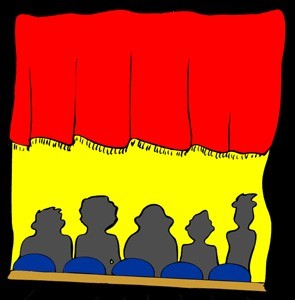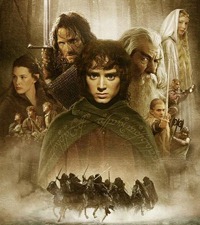By Joe Moore
Over at the Absolute Write forum, someone recently posted a request for advice on where to end the middle act of his novel. It was interesting to read the reactions, many of which expressed no idea that most novels are built on a 3-act structure. Now let me state right from the beginning that there are exceptions to every rule. And when it comes to writing fiction, the only rule is that there are no rules. But in general, most commercial fiction is usually based on a beginning,  middle and end structure. This comes from traditional stage drama, but unlike the theater, there’s no curtain dropping at the end of Act 1 and going up at the beginning of Act 2. Even though it’s not as obvious as when you attend a play at your local community theater, if you analyze most genre fiction you’ll find (or at least feel) where the three acts begin and end.
middle and end structure. This comes from traditional stage drama, but unlike the theater, there’s no curtain dropping at the end of Act 1 and going up at the beginning of Act 2. Even though it’s not as obvious as when you attend a play at your local community theater, if you analyze most genre fiction you’ll find (or at least feel) where the three acts begin and end.
So let’s take a look at the basic 3-act structure of a novel. In most cases, the beginning (Act 1), middle (Act 2) and ending (Act 3) are separated, not by points in time, but by major plotting points.
Act 1. The beginning is normally where the author introduces the reader to the setting/environment, the characters, their goals (wants and needs), and the conflict that impacts the protagonist’s life and launches the story. This impact knocks him or her from an ordinary situation into an extraordinary one. The protagonist might start out content with life, perhaps gliding along and comfortable in his or her niche. Then something happens to throw the protagonist out of the groove—an obstacle or roadblock that forces him or her to take some kind of action outside their comfort zone. It’s often a shock to their routine or a threat to their safety or someone close to them. Perhaps it even requires survival instincts to kick in. A path is created that will eventually bring the protagonist and antagonist into a final climactic scene. In Act 1, the “story  question” is usually established such as, “Will Frodo Baggins destroy the Ring before the Dark Lord takes over the Shire and all of Middle Earth?” In Lord Of The Rings, by the end of Act 1, Frodo has decided to set out, although reluctantly, and pursue his quest to save his homeland and his people. As he takes his first step on his quest, the curtain descends on Act 1.
question” is usually established such as, “Will Frodo Baggins destroy the Ring before the Dark Lord takes over the Shire and all of Middle Earth?” In Lord Of The Rings, by the end of Act 1, Frodo has decided to set out, although reluctantly, and pursue his quest to save his homeland and his people. As he takes his first step on his quest, the curtain descends on Act 1.
Act 2. The middle of the story often deals with a series of conflicts and obstacles that the protagonist must overcome in order to gain enough confidence to meet the final scene head-on. Arguably, the middle or “muddle” is the most challenging act to write, for the reader’s interest must be sustained while propelling the protagonist toward a goal that he or she and the reader desire. The element that fuels Act 2 is conflict, and each obstacle or test should build in severity from the previous one thus constantly raising the stakes and proceeding at a steady pace toward the end. The object here is to keep the reader reading. Remember too, that conflict does not always mean physical. It can be just as taxing and demanding when it’s emotional or spiritual. Act 2 also contains the lowest point in the story, emotionally or physically, for the protagonist. It usually occurs just before the end of Act 2 and the final Climax. It is the “darkest moment” in which all hope seems lost and the protagonist must summon up the final ounce of courage against all odds to resolve the story question. The resolution of the story question should happen at the Climax, and the curtain descends at the end of Act 2.
Act 3. The end is what some writers refer to as the “roundup”. This is where all loose ends, subplots, and lingering questions are answered. The reader should never finish the last page with any questions unanswered. The roundup is usually the final chapter, and because it’s hard to keep the reader’s attention after the climax, Act 3 should be short and to the point. Answer all the questions and proceed to the exits. There’s nothing left to see.
As readers, are you aware of the 3-Act structure in genre fiction? And as writers, do you think of it as you write, or is it more instinctive and subconscious? Have you ever written or read a book that was not based on the 3-Act form?

What can I say, Joe, but “Amen”? I’m a structure guy and the question about where to put the act breaks, and just what the heck are they anyway, is one of the most important. I call them “doorways of no return.” I think I’ll do a whole post about this for Sunday. Thanks for the sparker.
There are, BTW, many novels written without attending to the 3 act structure. They’re usually self-published.
This comment has been removed by the author.
As a writer, I do think of the 3-act structure…but then I’ve read, highlighted and reread James Scott Bell’s book.
Thanks so much for this post. It really helps. As a writer, I don’t always think of the 3-act structure, but maybe that’s why I’ve been having such a challenge. I’m burning it into my brain now! Thanks again.
Rita Lorraine
http://www.RitaHubbard.com
Jim, I’m looking forward to your Sunday post.
Teri, you’re taking advice from “the man” when you read Jim’s books.
Rita, thanks for dropping by. Glad the post helps.
Joe – I do think of it when I write and use it at the editing stage to make sure I’m tweaking things in the right way. I’m all for structure and outlines – even if you end up breaking the rules at least they were a good foundation to start with.
Agreed, Clare. When someone asks me how the writing is going, my answer is often something like: we’re well into act 2.
I have to underscore what they’re all saying about Jim’s book, PLOT & STRUCTURE. It’s concise, to the point, and presents what it has to say without any yawn-inducing academic stuff.
And most importantly, when it’s applied, it makes you a better writer.
Thanks, Mike. But you realize that you’re just giving Mr. Bell a big head. Although well deserved, I might add.
No worries, Joe. I just read a book on humility, so I obviously know more about it than you do.
Humility comes natural to me.
Act 1: Setting
Minor household project looms.
Act 2: Conflict
Minor household project gets promoted to major butt kicking job with steep learning curve to be achieved before wife returns with kids from swim lessons.
Act 3: Resolution
Household project completed with no structural damage and only minor surface issues that can be covered with repurposed wall hangings discovered in garage.
Humble project manager mumbles from corner:
“Does anyone know how to get gorilla glue out of hair?”
Update:
Re: repurposed wall hangings
Wife does not think USMC “Digital Marine” recruiting poster matches Thomas Kincaid decor of living room.
Thanks, Basil. You always put the icing on the cake. 🙂